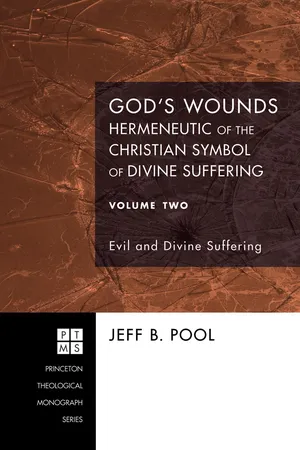
God's Wounds: Hermeneutic of the Christian Symbol of Divine Suffering, Volume Two
Evil and Divine Suffering
- 544 pages
- English
- ePUB (mobile friendly)
- Available on iOS & Android
God's Wounds: Hermeneutic of the Christian Symbol of Divine Suffering, Volume Two
Evil and Divine Suffering
About this book
This book constitutes the second volume of a three-volume study of Christian testimonies to divine suffering: God's Wounds: Hermeneutic of the Christian Symbol of Divine Suffering, vol. 2, Evil and Divine Suffering. The larger study focuses its inquiry into the testimonies to divine suffering themselves, seeking to allow the voices that attest to divine suffering to speak freely, then to discover and elucidate the internal logic or rationality of this family of testimonies, rather than defending these attestations against the dominant claims of classical Christian theism that have historically sought to eliminate such language altogether from Christian discourse about the nature and life of God. This second volume of studies proceeds on the basis of the presuppositions of this symbol, those implicit attestations that provide the conditions of possibility for divine suffering-that which constitutes divine vulnerability with respect to creation-as identified and examined in the first volume of this project: an understanding of God through the primary metaphor of love ("God is love"); and an understanding of the human as created in the image of God, with a life (though finite) analogous to the divine life-the imago Dei as love. The second volume then investigates the first two divine wounds or modes of divine suffering to which the larger family of testimonies to divine suffering normally attest: (1) divine grief, suffering because of betrayal by the beloved human or human sin; and (2) divine self-sacrifice, suffering for the beloved human in its bondage to sin or misery, to establish the possibility of redemption and reconciliation. Each divine wound, thus, constitutes a response to a creaturely occasion. The suffering in each divine wound also occurs in two stages: a passive stage and an active stage. In divine grief, God suffers because of human sin, betrayal of the divine lover by the beloved human: divine sorrow as the passive stage of divine grief; and divine anguish as the active stage of divine grief. In divine self-sacrifice, God suffers in response to the misery or bondage of the beloved human's infidelity: divine travail (focused on the divine incarnation in Jesus of Nazareth) as the active stage of divine self-sacrifice; and divine agony (focused on divine suffering in the crucifixion of Jesus of Nazareth) as the passive stage of divine self-sacrifice.
Frequently asked questions
- Essential is ideal for learners and professionals who enjoy exploring a wide range of subjects. Access the Essential Library with 800,000+ trusted titles and best-sellers across business, personal growth, and the humanities. Includes unlimited reading time and Standard Read Aloud voice.
- Complete: Perfect for advanced learners and researchers needing full, unrestricted access. Unlock 1.4M+ books across hundreds of subjects, including academic and specialized titles. The Complete Plan also includes advanced features like Premium Read Aloud and Research Assistant.
Please note we cannot support devices running on iOS 13 and Android 7 or earlier. Learn more about using the app.
Information
God’s First Wound: Divine Grief
Introduction to Part One:
The Structure of Divine Grief
Infidelity of the Beloved Human
Introduction to Division One:
Sin as Occasion of Divine Grief
Table of contents
- Title Page
- Preface
- Prologue: Central Mystery of the Christian Symbol of Divine Suffering
- Part One: God’s First Wound: Divine Grief
- Part Two: God’s Second Wound: Divine Self-Sacrifice
- Appendices
- Bibliography